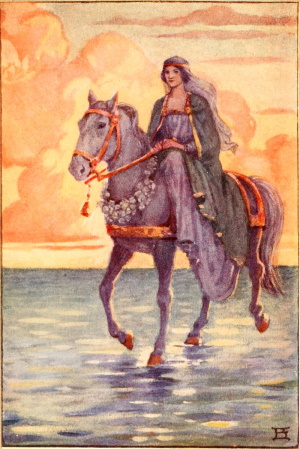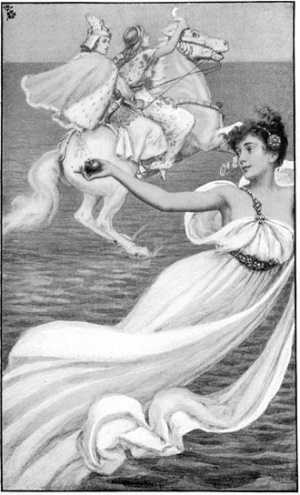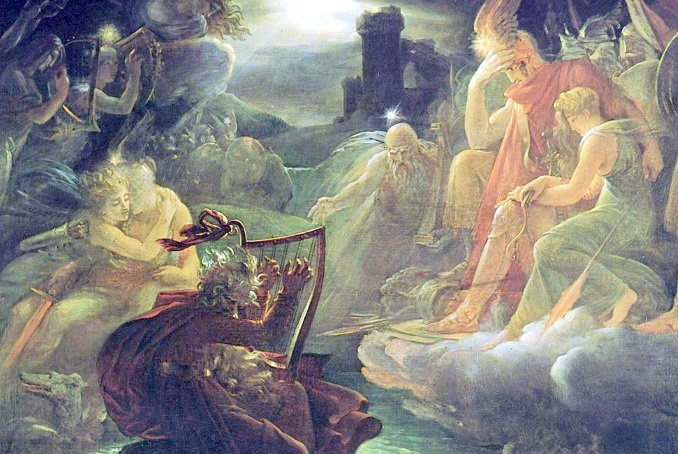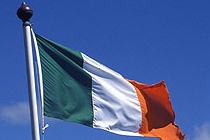Niamh Cinn-Óir and the Land of Tír na nÓg

The Fenian Cycle or Fianna Cycle (Irish: an Fhiannaíocht) in early Irish literature focuses on the exploits of the band of warriors known as the Fianna and their leader Fionn mac Cumhaill. Fionn mac Cumhaill is a hero in Irish as well as Scottish and Manx mythology. Much of the Fianna Cycle or Fenian Cycle is narrated by Fionn's son, the poet Oisín. The Fenian cycle remains an important part of Irish folklore passed down in oral tradition over many centuries.
A well known story from the Fenian Cycle is The Interrogation of the Old Men (Irish Agallamh Na Seanórach) probably compiled and written from older sources and oral tradition by a single author in about 1200. Other earlier tales were recorded in manuscripts and include The Book of the Dun Cow (c. 1100) and The Book of Leinster (c. 1160). The Fenian cycle is a key part of Irish folklore and contains many popular folk tales. Over the years a number of variations of the stories have been told and written.
One such popular story that has found its way into Irish folklore is of Golden-headed Niamh (Irish: Niamh Cinn-Óir) and her lover Oisín. Niamh lives in the land of Tír na nÓg (Land of the Young), which is one of the names for a part of the Celtic Otherworld. Tír na nÓg is described as an island paradise where there is everlasting youth, beauty, health, abundance and happiness. Its inhabitants are described as people of the Tuatha Dé Danann, the gods of pre-Christian Ireland.

This story tells of howOisin, when hunting with the others of the Fianna, heard the sound of an approaching horse. On the pure white horse rode Niamh Cinn-Óir, who was dressed like a princess and had long golden hair. She was the daughter of the King of Tír na nÓg. Niamh expalned that she had heard of Oisin and had travelled to meet him. Oisin fell in love with Niamh and together they crossed the sea on Niamh’s white mare together to reach the magical land of Tír na nÓg.
Niamh and Oison lived happily there for three hundred years. However, as the time passed a longing grew in Oisin to see again his homeland of Ireland and his people the Fianna. Although Niamh did not want him to go she realised she could not stop Oisin making the journey. Naimh warned him that if he went back to Ireland that he must not touch the ground of his homeland. If he did he would lose the gift of eternal youth and would age rapidly.
Oisin traveled back to his home on the magical white mare. When he arrived he found that his friends and family had died many years ago as he had been away for three hundred years. The castles he knew were in ruins and the time of the Fianna people had passed. Oisin saw a group of men trying to move a large rock and rode to the men to offer his assistance. He had not forgotten the warning Niamh had given him before leaving Tír na nÓg not to touch the ground in Ireland.

In order to avoid this he angled himself in his saddle to help move the stone without touching the ground. Unfortunately the saddle strap broke and Oisin fell onto Irish soil. He immediately began to age rapidly, gaining three hundred years. His magical horse fled back to Tír na nÓg and the alarmed men he sought to help carried him to Saint Patrick. He was able to recount to Saint Patrick his story of Niamh and the land Tír na nÓg before he died. Once he had finished his story Oisin was blessed by Saint Patrick then died and found eternal peace.
Content type:
- Irish
Language:
- English






